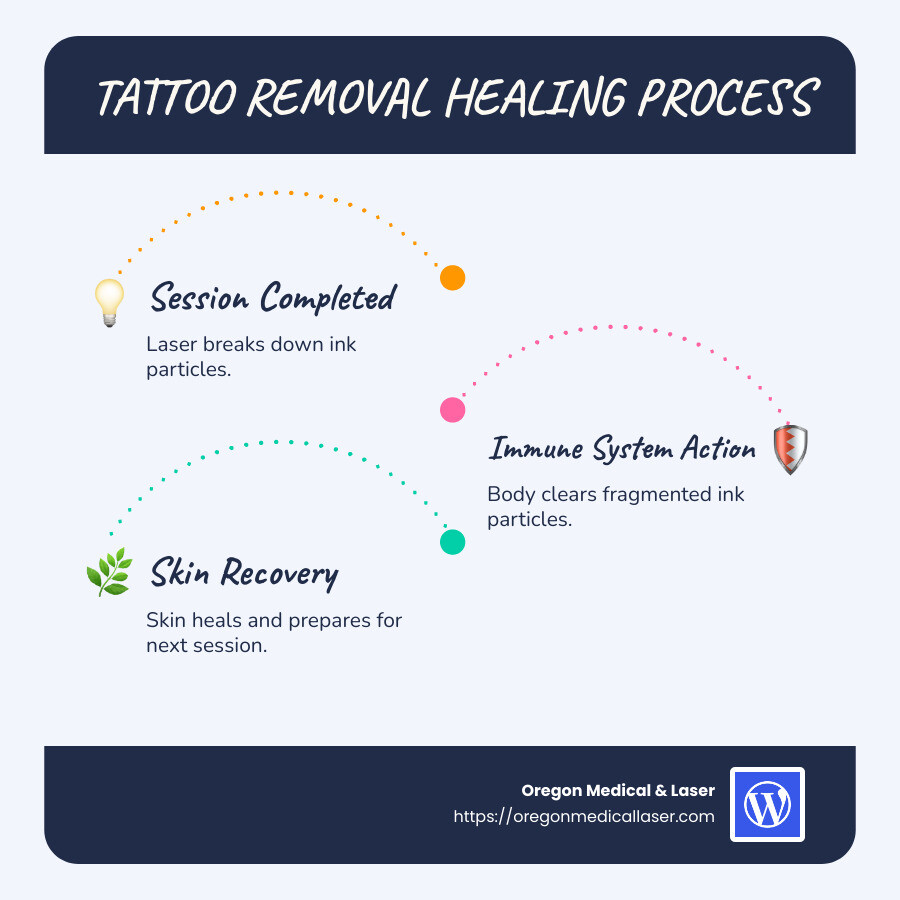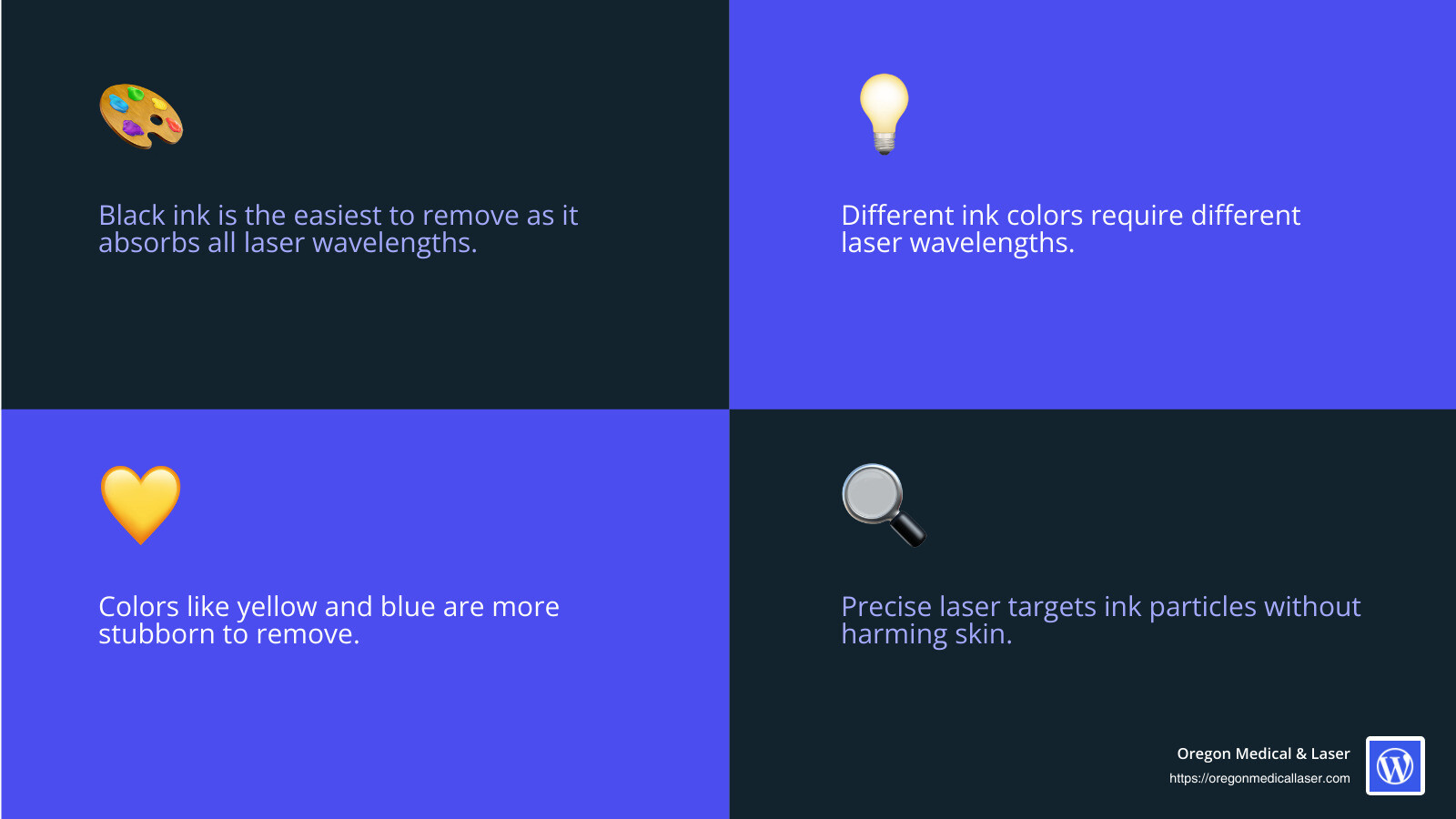The device matters! Discover how long between tattoo removal sessions ensures the best results and protects your skin.
Session Spacing: How Long Between Tattoo Removal Sessions?
November 1, 2024
4:27 pm
Staff

The device matters! Discover how long between tattoo removal sessions ensures the best results and protects your skin.

Oregon Medical and Laser is a leading provider of innovative healthcare solutions, dedicated to delivering exceptional patient care and cutting-edge aesthetic technologies.
How long between tattoo removal sessions? The quick answer: Typically, a wait time of four to eight weeks is recommended between sessions – our device allows treatments as soon as every two weeks, if the patient has fully healed from their prior session. This interval is crucial for allowing your skin to heal and your immune system to break down and remove the fragmented ink particles. Many people think the laser itself removed the ink, but it’s actually your own immune system! The last simply acts as a catalyst by ‘shattering’ and denaturing the ink from the cells and breaking it down to allow your own immune system to quickly continue the removal process.
Laser tattoo removal is a modern technique that turns those permanent designs into a thing of the past. However, removing a tattoo is more than just a quick decision—it involves patience and understanding of the healing process; it’s not a one-and-done appointment. Unlike the instant gratification of getting a tattoo, laser removal demands adherence to recommended session spacing for safety and effectiveness. Getting treated by an inferior device or an inexperienced technician can cause dermal scarring – nothing locks in tattoo ink like scarred skin.
The body’s resilience plays a pivotal role. After each session, your immune system works tirelessly to clear away the shattered ink particles. It’s this process that underscores why waiting is essential and why removal can be greatly impacted depending on the placement of the tattoo. For example, a tattoo on your chest will take fewer sessions and fade faster than tattoos on your hands and feet! Giving your body the necessary time between sessions not only reduces the risk of skin damage but also improves the overall result.
We will explore why letting the skin fully recover between treatments is crucial and dive deeper into how this spaced approach affects the complete removal of tattoos.

Laser tattoo removal is like using a magic eraser for your skin. Older lasers use Q-Switch technology, which was the original pioneer for your basic black tattoos. However, the current modern standard is a fractional pico-second tattoo, and unfortunately not all of them are the same! Our Candela PicoWay was the first device FDA approved to use photo-acoustic technology; firing and fractionating laser photons so quickly that they generate sound waves that act as the main agent to break up ink particles (all within a fraction of a fraction of a second!) This means, unlike Q-Switch, heat is a byproduct, and NOT the main mechanism used to break down the ink – an important distinction when dealing with sensitive skin!
The laser used in tattoo removal emits a powerful beam of light – we can even specify a wavelength that best treats the color or ink density type of your tattoo. This light is incredibly precise, targeting only the ink particles without harming the surrounding skin. It’s almost like a spotlight focusing on the ink while leaving everything else in the dark.
Different ink colors require different laser wavelengths. This means that some colors might need more sessions to fade away completely. For example, black ink absorbs all laser wavelengths, making it the easiest to remove. However, colors like yellow and blue can be more stubborn because they reflect more wavelengths.

The Q-Switched laser was a popular choice for tattoo removal, in fact, it was one of the lasers we used when we operated as Cascade Medical Tattoo Removal. It delivers short bursts of energy to use heat to help break the ink into smaller particles. This laser is known for its ability to work on various colors and was often preferred over IPL because it included hand pieces to address a few color treatment options and minimizes the risk of scarring over IPL.
Why does the device matter? The process might sound straightforward, but it’s a sophisticated dance between technology and your body’s natural healing. Each session is a step closer to a clean slate, but patience is key. Understanding how the laser works and the importance of waiting between sessions can set you up for success. The less damage and injury you receive during treatment, the faster you heal and allow your body to remove the ink.
Next, we’ll discuss why it’s crucial to wait between tattoo removal sessions and what happens if you don’t.
When it comes to laser tattoo removal, patience is more than just a virtue—it’s a necessity. The recommended wait time between sessions is two to eight weeks. This period is essential to allow your skin to heal properly and your immune system to work its magic.
Here’s why waiting is so important:
Skin Healing: On the surface, your skin may appear healed after a few days. However, the deeper layers take longer to recover. The healing time ensures that the skin beneath is ready for the next treatment without risk of damage. You may continue to have persistent pink or redness in the treatment area, and rarely you may experiencing small blisters if your tattoo is new or you’re just starting your removal journey.
Ink Elimination: Once the laser breaks the ink into tiny particles, your body’s lymphatic system takes over. This natural cleaning system gradually eliminates the ink fragments, a process that can continue into weeks four and five post-treatment. This is why the device matters – the smaller a laser device can shatter the ink particles, the easier it is for your immune system to remove them.
Immune System Support: A healthy immune system is crucial for efficient ink removal. Giving your body time between sessions helps your immune system clear out the ink particles, increasing the effectiveness of each session. There are certain medications which can cause photosensitization or inhibit immune response – our in-house physician reviews our patient’s medical records to ensure your receiving the right treatment for each session.
While it might be tempting to speed up the process, having sessions too close together can lead to complications:
Skin Irritation and Scarring: Rushing the process can irritate the skin, increasing the risk of scarring. The laser’s impact is significant, and your skin needs time to recover fully to avoid these adverse effects.
Overtreatment: Treating the skin too frequently can lead to overtreatment. This not only wastes time and money but also hinders the tattoo removal process. It can cause unnecessary stress on your skin and immune system, slowing down overall progress.
This may lead one to ask: “Can I remove my tattoo quickly?” In short, yes! We offer the DESCRIBE® patch – this is a prescription square silicone patch infused with perfluorodecalin. This patch absorbs the gasses that are released during removal and allows a provider to perform multiple ‘passes’ – in short, you can get and equivalent FOUR treatments in ONE session.
Next, we’ll explore the factors that influence how long you should wait between sessions, such as tattoo size, ink color, and skin type.
When considering how long between tattoo removal sessions is optimal, several factors play a significant role. Understanding these can help tailor the treatment plan to your specific needs.
Larger tattoos often require more attention and longer healing times. The more ink, the more work your immune system has to do. A larger surface area also means more skin is affected, which can extend the healing process. Therefore, bigger tattoos might need slightly longer intervals between sessions to ensure complete recovery.
The color of the ink is another critical factor. Different colors absorb laser light differently. For instance, black ink absorbs the most light and is typically easier to remove. However, colors like yellow and blue can be stubborn.
These colors might need additional sessions and longer recovery times between treatments to effectively break down the pigments.
Your skin type also impacts the spacing between sessions. People with lighter skin tones often experience faster fading, as the laser targets the ink without affecting the surrounding skin. However, those with darker skin tones need to be more cautious. The laser can affect melanin, increasing the risk of pigmentation changes.
To minimize this risk, longer intervals between sessions are recommended for individuals with darker skin, allowing the skin to heal and maintain its natural tone.
Each tattoo is unique, and so is every person’s skin. At Oregon Medical & Laser in Portland, OR, we emphasize personalized treatment plans. By considering these factors, we ensure each session is as effective as possible while prioritizing your skin’s health.
In the following section, we’ll address frequently asked questions about tattoo removal sessions, providing more insights into the process and what to expect.
Yes, it’s not recommended to undergo tattoo removal every 2 weeks unless you’re experiencing rapid healing and optimal fading. Healing time is crucial for your skin’s recovery and the effective elimination of ink particles. Experts suggest waiting four weeks between sessions. This duration allows the body’s immune system to clear away the fragmented ink and ensures that your skin remains healthy. Rushing this process could lead to skin irritation and increase the risk of scarring. This will vary based on patient, tattoo location, and number of sessions you’ve already completed.
Waiting longer between sessions can indeed be beneficial toward the end of your removal journey. Extended intervals allow for more significant fading of the tattoo, as the body’s natural processes have more time to work. Longer waits can also improve skin protection, reducing the risk of complications like pigmentation changes. However, there’s a balance to strike—waiting too long may slow down your overall removal timeline. Consulting with a our team can help determine the optimal schedule for your specific tattoo and skin type.
After completing your tattoo removal, ensure your skin has fully healed before getting a new tattoo. This means waiting until there is no scarring and the skin has returned to its normal state. Healing verification typically involves a professional assessment to confirm that the skin is ready for new ink. Patience during this phase is crucial to prevent any complications with the new tattoo.
Starting on a tattoo removal journey requires patience and planning. It’s not just about erasing an unwanted design; it’s about nurturing your skin back to health and ensuring the best possible results. At Oregon Medical & Laser, we understand the importance of a thoughtful approach to tattoo removal. Our team is dedicated to providing personalized care and cutting-edge treatments that prioritize both safety and effectiveness.
Being patient with the process is key. Every step, from the initial consultation to each laser session, is designed to protect your skin and maximize the fading of the tattoo. As tempting as it might be to speed things up, adherence to recommended intervals between sessions ensures the best outcome while minimizing risks such as skin irritation and scarring.
Planning your tattoo removal schedule with the help of experts can greatly influence the success of the treatment. We assist you in understanding the factors that affect your removal timeline, including tattoo size, ink color, and skin type. By doing so, we help you make informed decisions that align with your goals and skin health.
Partner with us at Oregon Medical & Laser to start on your journey to clear skin. Our commitment is to guide you every step of the way, ensuring a smooth and effective tattoo removal experience. Let us help you reclaim your skin with confidence and care.